CHEVROLET MALIBU 2017 9.G Owners Manual
Manufacturer: CHEVROLET, Model Year: 2017, Model line: MALIBU, Model: CHEVROLET MALIBU 2017 9.GPages: 419, PDF Size: 7.81 MB
Page 241 of 419
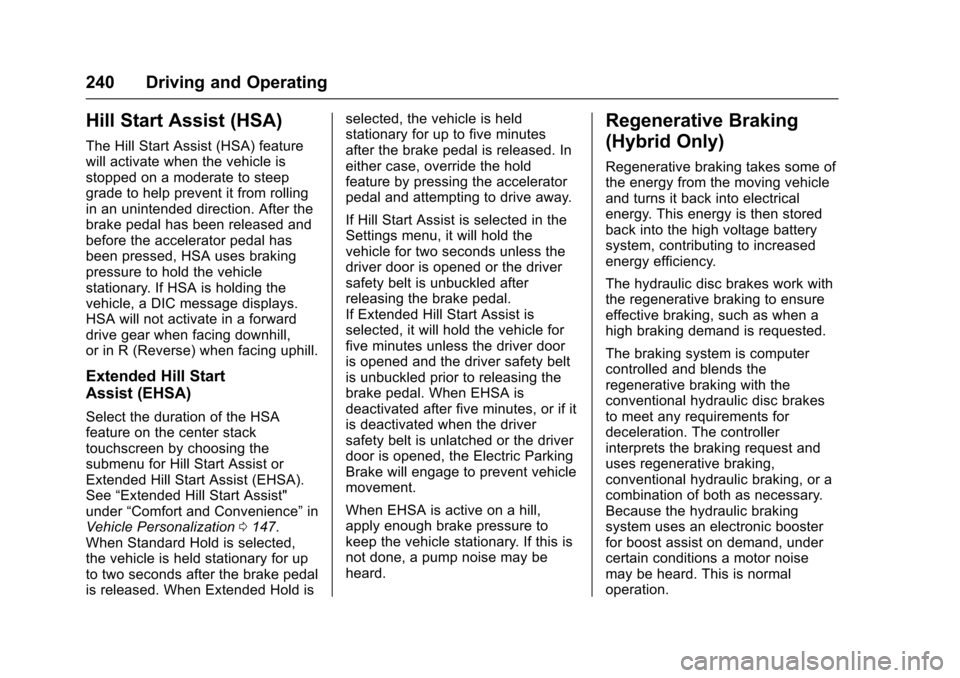
Chevrolet Malibu Owner Manual (GMNA-Localizing-U.S./Canada/Mexico-10122664) - 2017 - crc - 5/23/16
240 Driving and Operating
Hill Start Assist (HSA)
The Hill Start Assist (HSA) featurewill activate when the vehicle isstopped on a moderate to steepgrade to help prevent it from rollingin an unintended direction. After thebrake pedal has been released andbefore the accelerator pedal hasbeen pressed, HSA uses brakingpressure to hold the vehiclestationary. If HSA is holding thevehicle, a DIC message displays.HSA will not activate in a forwarddrive gear when facing downhill,or in R (Reverse) when facing uphill.
Extended Hill Start
Assist (EHSA)
Select the duration of the HSAfeature on the center stacktouchscreen by choosing thesubmenu for Hill Start Assist orExtended Hill Start Assist (EHSA).See“Extended Hill Start Assist"under“Comfort and Convenience”inVehicle Personalization0147.When Standard Hold is selected,the vehicle is held stationary for upto two seconds after the brake pedalis released. When Extended Hold is
selected, the vehicle is heldstationary for up to five minutesafter the brake pedal is released. Ineither case, override the holdfeature by pressing the acceleratorpedal and attempting to drive away.
If Hill Start Assist is selected in theSettings menu, it will hold thevehicle for two seconds unless thedriver door is opened or the driversafety belt is unbuckled afterreleasing the brake pedal.If Extended Hill Start Assist isselected, it will hold the vehicle forfive minutes unless the driver dooris opened and the driver safety beltis unbuckled prior to releasing thebrake pedal. When EHSA isdeactivated after five minutes, or if itis deactivated when the driversafety belt is unlatched or the driverdoor is opened, the Electric ParkingBrake will engage to prevent vehiclemovement.
When EHSA is active on a hill,apply enough brake pressure tokeep the vehicle stationary. If this isnot done, a pump noise may beheard.
Regenerative Braking
(Hybrid Only)
Regenerative braking takes some ofthe energy from the moving vehicleand turns it back into electricalenergy. This energy is then storedback into the high voltage batterysystem, contributing to increasedenergy efficiency.
The hydraulic disc brakes work withthe regenerative braking to ensureeffective braking, such as when ahigh braking demand is requested.
The braking system is computercontrolled and blends theregenerative braking with theconventional hydraulic disc brakesto meet any requirements fordeceleration. The controllerinterprets the braking request anduses regenerative braking,conventional hydraulic braking, or acombination of both as necessary.Because the hydraulic brakingsystem uses an electronic boosterfor boost assist on demand, undercertain conditions a motor noisemay be heard. This is normaloperation.
Page 242 of 419
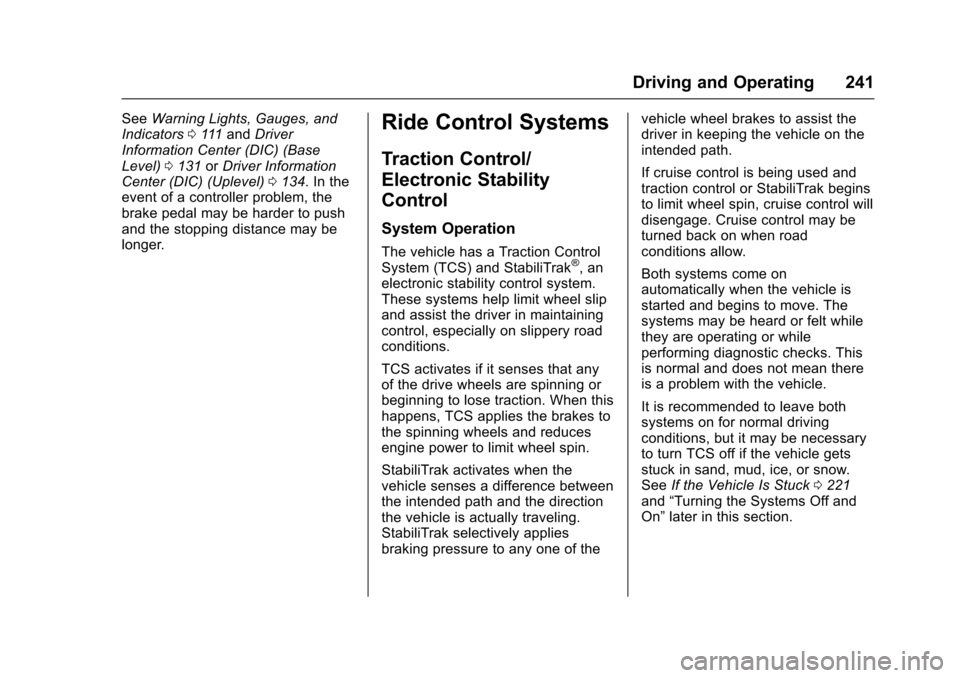
Chevrolet Malibu Owner Manual (GMNA-Localizing-U.S./Canada/Mexico-10122664) - 2017 - crc - 5/23/16
Driving and Operating 241
SeeWarning Lights, Gauges, andIndicators0111andDriverInformation Center (DIC) (BaseLevel)0131orDriver InformationCenter (DIC) (Uplevel)0134.Intheevent of a controller problem, thebrake pedal may be harder to pushand the stopping distance may belonger.
Ride Control Systems
Traction Control/
Electronic Stability
Control
System Operation
The vehicle has a Traction ControlSystem (TCS) and StabiliTrak®,anelectronic stability control system.These systems help limit wheel slipand assist the driver in maintainingcontrol, especially on slippery roadconditions.
TCS activates if it senses that anyof the drive wheels are spinning orbeginning to lose traction. When thishappens, TCS applies the brakes tothe spinning wheels and reducesengine power to limit wheel spin.
StabiliTrak activates when thevehicle senses a difference betweenthe intended path and the directionthe vehicle is actually traveling.StabiliTrak selectively appliesbraking pressure to any one of the
vehicle wheel brakes to assist thedriver in keeping the vehicle on theintended path.
If cruise control is being used andtraction control or StabiliTrak beginsto limit wheel spin, cruise control willdisengage. Cruise control may beturned back on when roadconditions allow.
Both systems come onautomatically when the vehicle isstarted and begins to move. Thesystems may be heard or felt whilethey are operating or whileperforming diagnostic checks. Thisis normal and does not mean thereis a problem with the vehicle.
It is recommended to leave bothsystems on for normal drivingconditions, but it may be necessaryto turn TCS off if the vehicle getsstuck in sand, mud, ice, or snow.SeeIf the Vehicle Is Stuck0221and“Turning the Systems Off andOn”later in this section.
Page 243 of 419
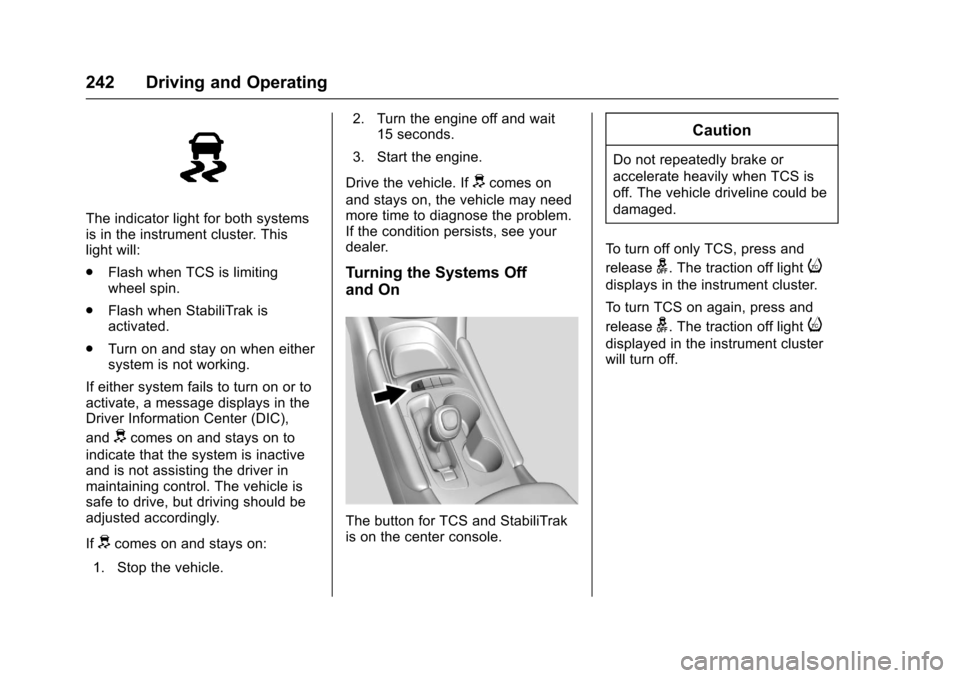
Chevrolet Malibu Owner Manual (GMNA-Localizing-U.S./Canada/Mexico-10122664) - 2017 - crc - 5/23/16
242 Driving and Operating
The indicator light for both systemsis in the instrument cluster. Thislight will:
.Flash when TCS is limitingwheel spin.
.Flash when StabiliTrak isactivated.
.Turn on and stay on when eithersystem is not working.
If either system fails to turn on or toactivate, a message displays in theDriver Information Center (DIC),
anddcomes on and stays on to
indicate that the system is inactiveand is not assisting the driver inmaintaining control. The vehicle issafe to drive, but driving should beadjusted accordingly.
Ifdcomes on and stays on:
1. Stop the vehicle.
2. Turn the engine off and wait15 seconds.
3. Start the engine.
Drive the vehicle. Ifdcomes on
and stays on, the vehicle may needmore time to diagnose the problem.If the condition persists, see yourdealer.
Turning the Systems Off
and On
The button for TCS and StabiliTrakis on the center console.
Caution
Do not repeatedly brake or
accelerate heavily when TCS is
off. The vehicle driveline could be
damaged.
To t u r n o f f o n l y T C S , p r e s s a n d
releaseg.Thetractionofflighti
displays in the instrument cluster.
To t u r n T C S o n a g a i n , p r e s s a n d
releaseg.Thetractionofflighti
displayed in the instrument clusterwill turn off.
Page 244 of 419
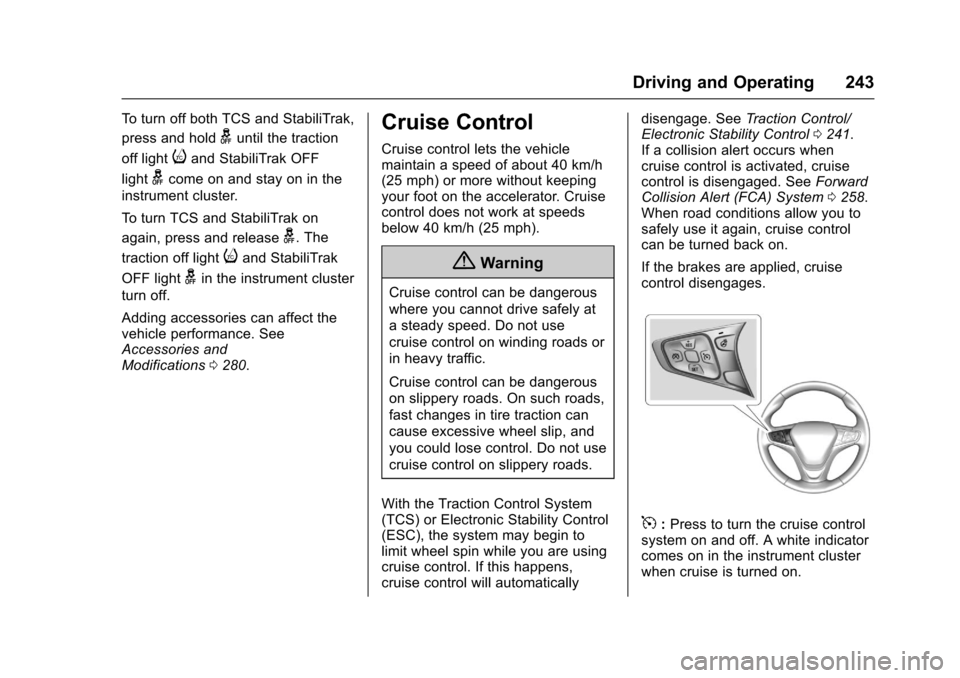
Chevrolet Malibu Owner Manual (GMNA-Localizing-U.S./Canada/Mexico-10122664) - 2017 - crc - 5/23/16
Driving and Operating 243
To t u r n o f f b o t h T C S a n d S t a b i l i T r a k ,
press and holdguntil the traction
off lightiand StabiliTrak OFF
lightgcome on and stay on in the
instrument cluster.
To t u r n T C S a n d S t a b i l i T r a k o n
again, press and releaseg.The
traction off lightiand StabiliTrak
OFF lightgin the instrument cluster
turn off.
Adding accessories can affect thevehicle performance. SeeAccessories andModifications0280.
Cruise Control
Cruise control lets the vehiclemaintain a speed of about 40 km/h(25 mph) or more without keepingyour foot on the accelerator. Cruisecontrol does not work at speedsbelow 40 km/h (25 mph).
{Warning
Cruise control can be dangerous
where you cannot drive safely at
asteadyspeed.Donotuse
cruise control on winding roads or
in heavy traffic.
Cruise control can be dangerous
on slippery roads. On such roads,
fast changes in tire traction can
cause excessive wheel slip, and
you could lose control. Do not use
cruise control on slippery roads.
With the Traction Control System(TCS) or Electronic Stability Control(ESC), the system may begin tolimit wheel spin while you are usingcruise control. If this happens,cruise control will automatically
disengage. SeeTr a c t i o n C o n t r o l /Electronic Stability Control0241.If a collision alert occurs whencruise control is activated, cruisecontrol is disengaged. SeeForwardCollision Alert (FCA) System0258.When road conditions allow you tosafely use it again, cruise controlcan be turned back on.
If the brakes are applied, cruisecontrol disengages.
5:Press to turn the cruise controlsystem on and off. A white indicatorcomes on in the instrument clusterwhen cruise is turned on.
Page 245 of 419
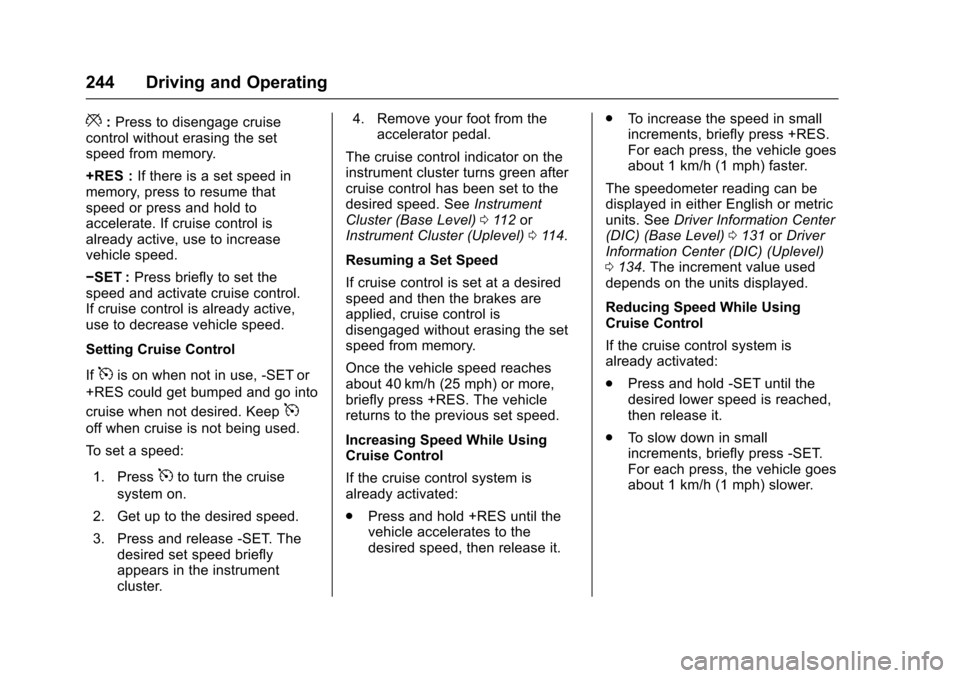
Chevrolet Malibu Owner Manual (GMNA-Localizing-U.S./Canada/Mexico-10122664) - 2017 - crc - 5/23/16
244 Driving and Operating
*:Press to disengage cruisecontrol without erasing the setspeed from memory.
+RES :If there is a set speed inmemory, press to resume thatspeed or press and hold toaccelerate. If cruise control isalready active, use to increasevehicle speed.
✓SET :Press briefly to set thespeed and activate cruise control.If cruise control is already active,use to decrease vehicle speed.
Setting Cruise Control
If5is on when not in use, -SET or
+RES could get bumped and go into
cruise when not desired. Keep5
off when cruise is not being used.
To s e t a s p e e d :
1. Press5to turn the cruise
system on.
2. Get up to the desired speed.
3. Press and release -SET. Thedesired set speed brieflyappears in the instrumentcluster.
4. Remove your foot from theaccelerator pedal.
The cruise control indicator on theinstrument cluster turns green aftercruise control has been set to thedesired speed. SeeInstrumentCluster (Base Level)011 2orInstrument Cluster (Uplevel)011 4.
Resuming a Set Speed
If cruise control is set at a desiredspeed and then the brakes areapplied, cruise control isdisengaged without erasing the setspeed from memory.
Once the vehicle speed reachesabout 40 km/h (25 mph) or more,briefly press +RES. The vehiclereturns to the previous set speed.
Increasing Speed While UsingCruise Control
If the cruise control system isalready activated:
.Press and hold +RES until thevehicle accelerates to thedesired speed, then release it.
.To i n c r e a s e t h e s p e e d i n s m a l lincrements, briefly press +RES.For each press, the vehicle goesabout 1 km/h (1 mph) faster.
The speedometer reading can bedisplayed in either English or metricunits. SeeDriver Information Center(DIC) (Base Level)0131orDriverInformation Center (DIC) (Uplevel)0134.Theincrementvalueuseddepends on the units displayed.
Reducing Speed While UsingCruise Control
If the cruise control system isalready activated:
.Press and hold -SET until thedesired lower speed is reached,then release it.
.To s l o w d o w n i n s m a l lincrements, briefly press -SET.For each press, the vehicle goesabout 1 km/h (1 mph) slower.
Page 246 of 419
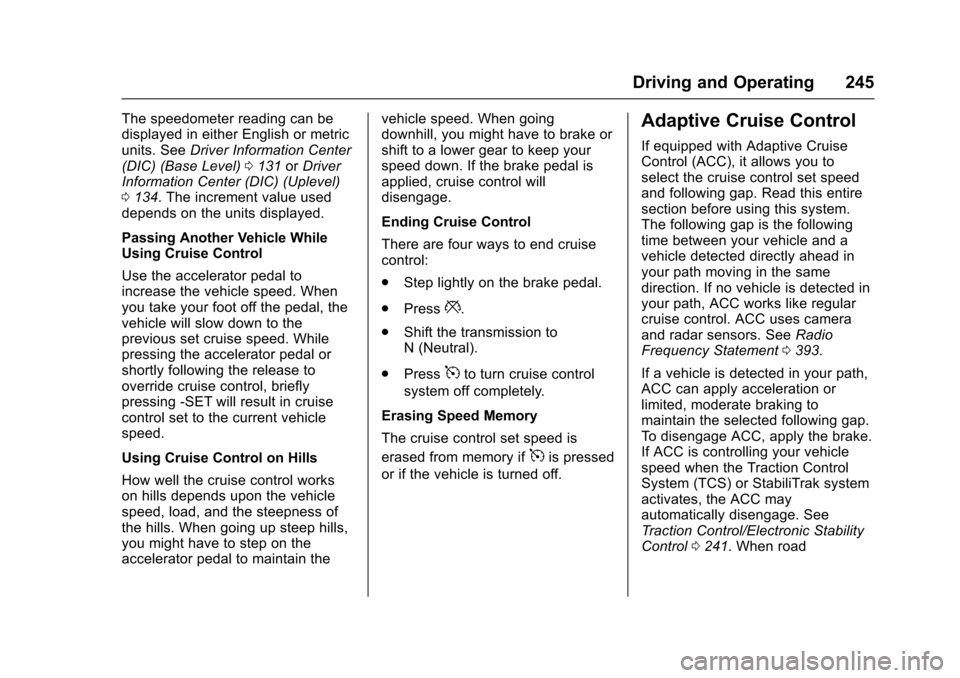
Chevrolet Malibu Owner Manual (GMNA-Localizing-U.S./Canada/Mexico-10122664) - 2017 - crc - 5/23/16
Driving and Operating 245
The speedometer reading can bedisplayed in either English or metricunits. SeeDriver Information Center(DIC) (Base Level)0131orDriverInformation Center (DIC) (Uplevel)0134.Theincrementvalueuseddepends on the units displayed.
Passing Another Vehicle WhileUsing Cruise Control
Use the accelerator pedal toincrease the vehicle speed. Whenyou take your foot off the pedal, thevehicle will slow down to theprevious set cruise speed. Whilepressing the accelerator pedal orshortly following the release tooverride cruise control, brieflypressing -SET will result in cruisecontrol set to the current vehiclespeed.
Using Cruise Control on Hills
How well the cruise control workson hills depends upon the vehiclespeed, load, and the steepness ofthe hills. When going up steep hills,you might have to step on theaccelerator pedal to maintain the
vehicle speed. When goingdownhill, you might have to brake orshift to a lower gear to keep yourspeed down. If the brake pedal isapplied, cruise control willdisengage.
Ending Cruise Control
There are four ways to end cruisecontrol:
.Step lightly on the brake pedal.
.Press*.
.Shift the transmission toN(Neutral).
.Press5to turn cruise control
system off completely.
Erasing Speed Memory
The cruise control set speed is
erased from memory if5is pressed
or if the vehicle is turned off.
Adaptive Cruise Control
If equipped with Adaptive CruiseControl (ACC), it allows you toselect the cruise control set speedand following gap. Read this entiresection before using this system.The following gap is the followingtime between your vehicle and avehicle detected directly ahead inyour path moving in the samedirection. If no vehicle is detected inyour path, ACC works like regularcruise control. ACC uses cameraand radar sensors. SeeRadioFrequency Statement0393.
If a vehicle is detected in your path,ACC can apply acceleration orlimited, moderate braking tomaintain the selected following gap.To d i s e n g a g e A C C , a p p l y t h e b r a k e .If ACC is controlling your vehiclespeed when the Traction ControlSystem (TCS) or StabiliTrak systemactivates, the ACC mayautomatically disengage. SeeTr a c t i o n C o n t r o l / E l e c t r o n i c S t a b i l i t yControl0241.Whenroad
Page 247 of 419
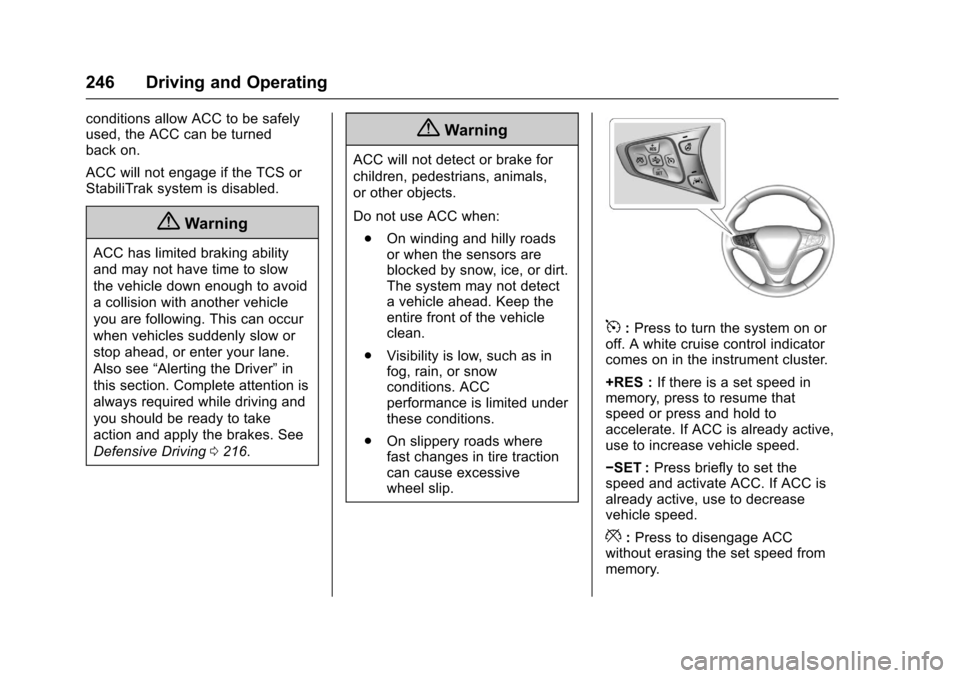
Chevrolet Malibu Owner Manual (GMNA-Localizing-U.S./Canada/Mexico-10122664) - 2017 - crc - 5/23/16
246 Driving and Operating
conditions allow ACC to be safelyused, the ACC can be turnedback on.
ACC will not engage if the TCS orStabiliTrak system is disabled.
{Warning
ACC has limited braking ability
and may not have time to slow
the vehicle down enough to avoid
acollisionwithanothervehicle
you are following. This can occur
when vehicles suddenly slow or
stop ahead, or enter your lane.
Also see“Alerting the Driver”in
this section. Complete attention is
always required while driving and
you should be ready to take
action and apply the brakes. See
Defensive Driving0216.
{Warning
ACC will not detect or brake for
children, pedestrians, animals,
or other objects.
Do not use ACC when:
.On winding and hilly roadsor when the sensors areblocked by snow, ice, or dirt.The system may not detectavehicleahead.Keeptheentire front of the vehicleclean.
.Visibility is low, such as infog, rain, or snowconditions. ACCperformance is limited underthese conditions.
.On slippery roads wherefast changes in tire tractioncan cause excessivewheel slip.
5:Press to turn the system on oroff. A white cruise control indicatorcomes on in the instrument cluster.
+RES :If there is a set speed inmemory, press to resume thatspeed or press and hold toaccelerate. If ACC is already active,use to increase vehicle speed.
✓SET :Press briefly to set thespeed and activate ACC. If ACC isalready active, use to decreasevehicle speed.
*:Press to disengage ACCwithout erasing the set speed frommemory.
Page 248 of 419
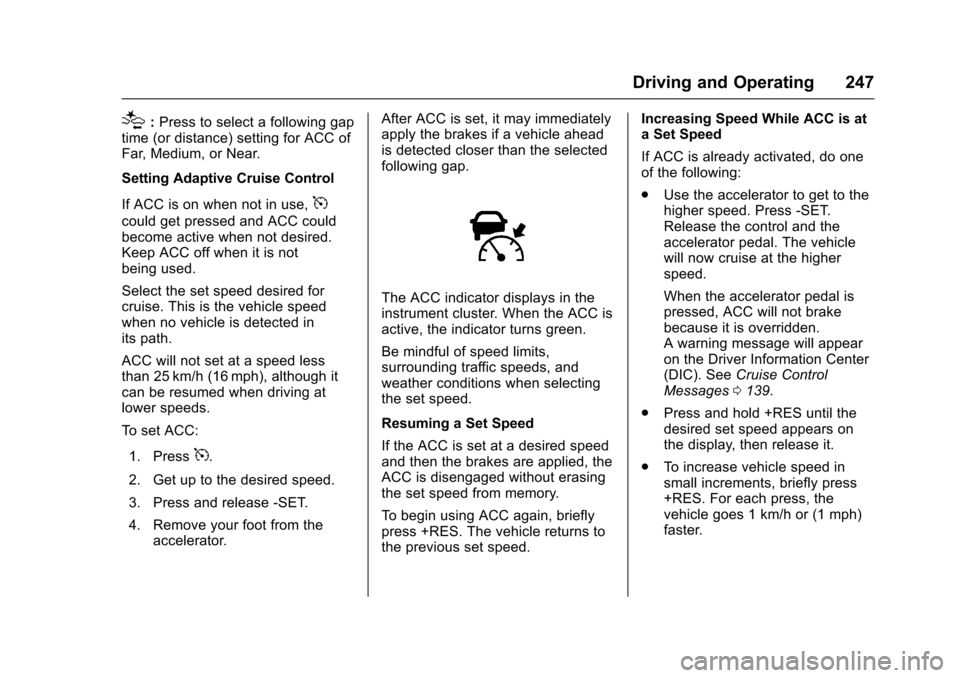
Chevrolet Malibu Owner Manual (GMNA-Localizing-U.S./Canada/Mexico-10122664) - 2017 - crc - 5/23/16
Driving and Operating 247
[:Press to select a following gaptime (or distance) setting for ACC ofFar, Medium, or Near.
Setting Adaptive Cruise Control
If ACC is on when not in use,5
could get pressed and ACC couldbecome active when not desired.Keep ACC off when it is notbeing used.
Select the set speed desired forcruise. This is the vehicle speedwhen no vehicle is detected inits path.
ACC will not set at a speed lessthan 25 km/h (16 mph), although itcan be resumed when driving atlower speeds.
To s e t A C C :
1. Press5.
2. Get up to the desired speed.
3. Press and release -SET.
4. Remove your foot from theaccelerator.
After ACC is set, it may immediatelyapply the brakes if a vehicle aheadis detected closer than the selectedfollowing gap.
The ACC indicator displays in theinstrument cluster. When the ACC isactive, the indicator turns green.
Be mindful of speed limits,surrounding traffic speeds, andweather conditions when selectingthe set speed.
Resuming a Set Speed
If the ACC is set at a desired speedand then the brakes are applied, theACC is disengaged without erasingthe set speed from memory.
To b e g i n u s i n g A C C a g a i n , b r i e f l ypress +RES. The vehicle returns tothe previous set speed.
Increasing Speed While ACC is ata Set Speed
If ACC is already activated, do oneof the following:
.Use the accelerator to get to thehigher speed. Press -SET.Release the control and theaccelerator pedal. The vehiclewill now cruise at the higherspeed.
When the accelerator pedal ispressed, ACC will not brakebecause it is overridden.Awarningmessagewillappearon the Driver Information Center(DIC). SeeCruise ControlMessages0139.
.Press and hold +RES until thedesired set speed appears onthe display, then release it.
.To i n c r e a s e v e h i c l e s p e e d i nsmall increments, briefly press+RES. For each press, thevehicle goes 1 km/h or (1 mph)faster.
Page 249 of 419
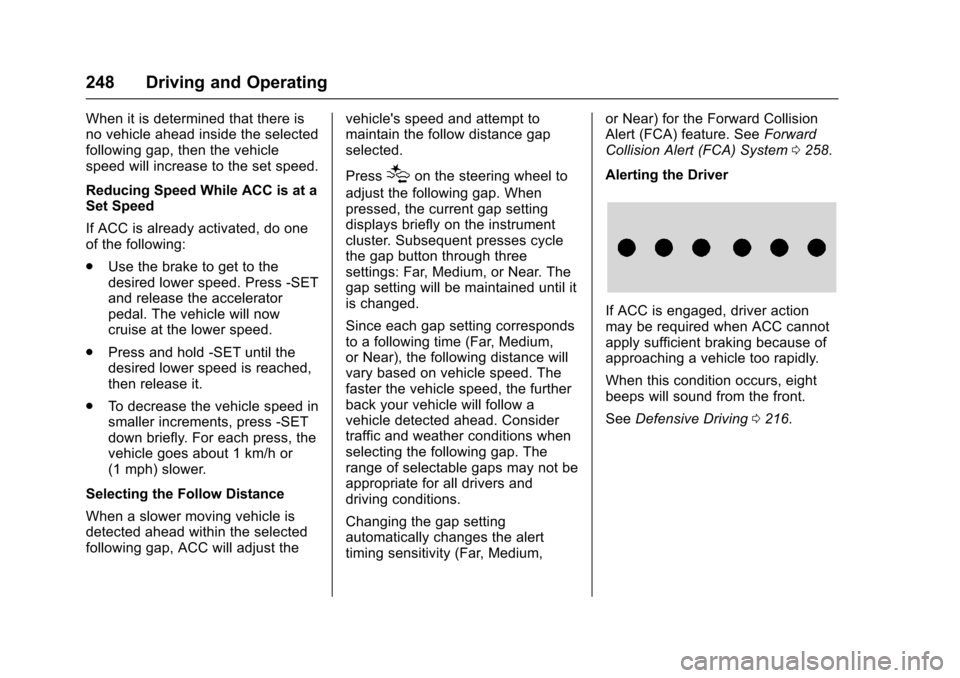
Chevrolet Malibu Owner Manual (GMNA-Localizing-U.S./Canada/Mexico-10122664) - 2017 - crc - 5/23/16
248 Driving and Operating
When it is determined that there isno vehicle ahead inside the selectedfollowing gap, then the vehiclespeed will increase to the set speed.
Reducing Speed While ACC is at aSet Speed
If ACC is already activated, do oneof the following:
.Use the brake to get to thedesired lower speed. Press -SETand release the acceleratorpedal. The vehicle will nowcruise at the lower speed.
.Press and hold -SET until thedesired lower speed is reached,then release it.
.To d e c r e a s e t h e v e h i c l e s p e e d i nsmaller increments, press -SETdown briefly. For each press, thevehicle goes about 1 km/h or(1 mph) slower.
Selecting the Follow Distance
When a slower moving vehicle isdetected ahead within the selectedfollowing gap, ACC will adjust the
vehicle's speed and attempt tomaintain the follow distance gapselected.
Press[on the steering wheel to
adjust the following gap. Whenpressed, the current gap settingdisplays briefly on the instrumentcluster. Subsequent presses cyclethe gap button through threesettings: Far, Medium, or Near. Thegap setting will be maintained until itis changed.
Since each gap setting correspondsto a following time (Far, Medium,or Near), the following distance willvary based on vehicle speed. Thefaster the vehicle speed, the furtherback your vehicle will follow avehicle detected ahead. Considertraffic and weather conditions whenselecting the following gap. Therange of selectable gaps may not beappropriate for all drivers anddriving conditions.
Changing the gap settingautomatically changes the alerttiming sensitivity (Far, Medium,
or Near) for the Forward CollisionAlert (FCA) feature. SeeForwardCollision Alert (FCA) System0258.
Alerting the Driver
If ACC is engaged, driver actionmay be required when ACC cannotapply sufficient braking because ofapproaching a vehicle too rapidly.
When this condition occurs, eightbeeps will sound from the front.
SeeDefensive Driving0216.
Page 250 of 419
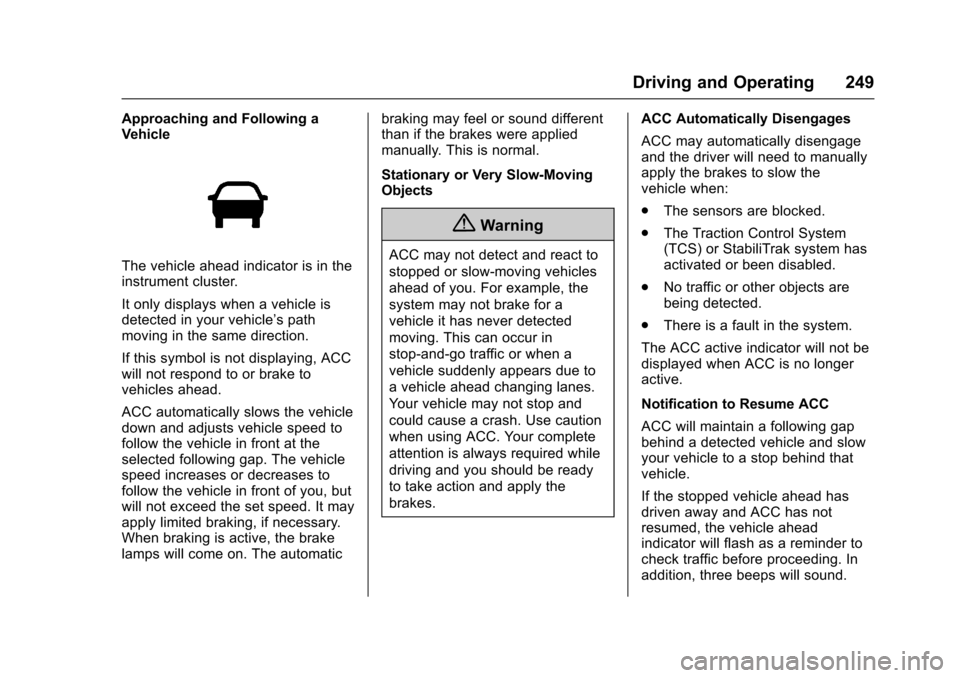
Chevrolet Malibu Owner Manual (GMNA-Localizing-U.S./Canada/Mexico-10122664) - 2017 - crc - 5/23/16
Driving and Operating 249
Approaching and Following aVehicle
The vehicle ahead indicator is in theinstrument cluster.
It only displays when a vehicle isdetected in your vehicle’spathmoving in the same direction.
If this symbol is not displaying, ACCwill not respond to or brake tovehicles ahead.
ACC automatically slows the vehicledown and adjusts vehicle speed tofollow the vehicle in front at theselected following gap. The vehiclespeed increases or decreases tofollow the vehicle in front of you, butwill not exceed the set speed. It mayapply limited braking, if necessary.When braking is active, the brakelamps will come on. The automatic
braking may feel or sound differentthan if the brakes were appliedmanually. This is normal.
Stationary or Very Slow-MovingObjects
{Warning
ACC may not detect and react to
stopped or slow-moving vehicles
ahead of you. For example, the
system may not brake for a
vehicle it has never detected
moving. This can occur in
stop-and-go traffic or when a
vehicle suddenly appears due to
avehicleaheadchanginglanes.
Yo u r v e h i c l e m a y n o t s t o p a n d
could cause a crash. Use caution
when using ACC. Your complete
attention is always required while
driving and you should be ready
to take action and apply the
brakes.
ACC Automatically Disengages
ACC may automatically disengageand the driver will need to manuallyapply the brakes to slow thevehicle when:
.The sensors are blocked.
.The Traction Control System(TCS) or StabiliTrak system hasactivated or been disabled.
.No traffic or other objects arebeing detected.
.There is a fault in the system.
The ACC active indicator will not bedisplayed when ACC is no longeractive.
Notification to Resume ACC
ACC will maintain a following gapbehind a detected vehicle and slowyour vehicle to a stop behind thatvehicle.
If the stopped vehicle ahead hasdriven away and ACC has notresumed, the vehicle aheadindicator will flash as a reminder tocheck traffic before proceeding. Inaddition, three beeps will sound.